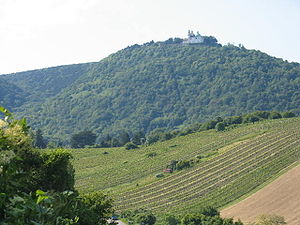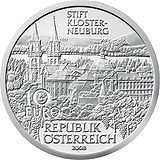
Leopoldsberg
Encyclopedia


Vienna
Vienna is the capital and largest city of the Republic of Austria and one of the nine states of Austria. Vienna is Austria's primary city, with a population of about 1.723 million , and is by far the largest city in Austria, as well as its cultural, economic, and political centre...
’s most famous overlook, towering over the Danube
Danube
The Danube is a river in the Central Europe and the Europe's second longest river after the Volga. It is classified as an international waterway....
and the city. Leopoldberg’s most prominent landmark is the church which stands at the top, and which is clearly visible from Vienna below. The construction of Saint Leopold
Saint Leopold
Saint Leopold may refer to:* Leopold III, Margrave of Austria , patron saint of Austria* Leopold Mandić , Croat-born saint*Saint Leopold Church , Vienna, Austria...
's Church on Leopoldsberg began in 1679; an expansion following a design by Antonio Beduzzi
Antonio Beduzzi
Antonio Maria Nicolao Beduzzi was an Austrian-Italian theater engineer, painter, and architect who flourished in Vienna at the turn of the 17th century....
was undertaken from 1718 to 1730. Other renovations were to follow. Across the square from the church, on what used to be a tower of the fortification system, a memorial to those Austrians who returned home from captivity after World War II
World War II
World War II, or the Second World War , was a global conflict lasting from 1939 to 1945, involving most of the world's nations—including all of the great powers—eventually forming two opposing military alliances: the Allies and the Axis...
was created in 1948.
Geography
Leopoldberg forms the northeastern corner of the AlpsAlps
The Alps is one of the great mountain range systems of Europe, stretching from Austria and Slovenia in the east through Italy, Switzerland, Liechtenstein and Germany to France in the west....
. Alternating layers of marl
Marl
Marl or marlstone is a calcium carbonate or lime-rich mud or mudstone which contains variable amounts of clays and aragonite. Marl was originally an old term loosely applied to a variety of materials, most of which occur as loose, earthy deposits consisting chiefly of an intimate mixture of clay...
(rich in carbonate
Carbonate
In chemistry, a carbonate is a salt of carbonic acid, characterized by the presence of the carbonate ion, . The name may also mean an ester of carbonic acid, an organic compound containing the carbonate group C2....
) and sandstone
Sandstone
Sandstone is a sedimentary rock composed mainly of sand-sized minerals or rock grains.Most sandstone is composed of quartz and/or feldspar because these are the most common minerals in the Earth's crust. Like sand, sandstone may be any colour, but the most common colours are tan, brown, yellow,...
form the parent rock. Unlike most of the mountains of the flysch
Flysch
Flysch is a sequence of sedimentary rocks that is deposited in a deep marine facies in the foreland basin of a developing orogen. Flysch is typically deposited during an early stage of the orogenesis. When the orogen evolves the foreland basin becomes shallower and molasse is deposited on top of...
zone (Upper Cretaceous and Tertiary periods), the Leopoldsberg has steep slopes due to the erosive power of the river Danube on one side and of a small creek on the other. This relief intensifies the differences in local climate and vegetation, which are provided by the borderline between Pannonic
Pannonia
Pannonia was an ancient province of the Roman Empire bounded north and east by the Danube, coterminous westward with Noricum and upper Italy, and southward with Dalmatia and upper Moesia....
and Central European climates. The northern slope is covered with beech
Beech
Beech is a genus of ten species of deciduous trees in the family Fagaceae, native to temperate Europe, Asia and North America.-Habit:...
forests, the most common forest type of the Wienerwald
Wienerwald
The Vienna Woods are forested highlands that form the northeastern foothills of the Northern Limestone Alps in the states of Lower Austria and Vienna. The long and wide hill range is heavily wooded and a popular recreation area with the Viennese....
.
History
Human settlements are known since the Stone AgeStone Age
The Stone Age is a broad prehistoric period, lasting about 2.5 million years , during which humans and their predecessor species in the genus Homo, as well as the earlier partly contemporary genera Australopithecus and Paranthropus, widely used exclusively stone as their hard material in the...
and especially from Celt
Celt
The Celts were a diverse group of tribal societies in Iron Age and Roman-era Europe who spoke Celtic languages.The earliest archaeological culture commonly accepted as Celtic, or rather Proto-Celtic, was the central European Hallstatt culture , named for the rich grave finds in Hallstatt, Austria....
ic people during the Iron Age
Iron Age
The Iron Age is the archaeological period generally occurring after the Bronze Age, marked by the prevalent use of iron. The early period of the age is characterized by the widespread use of iron or steel. The adoption of such material coincided with other changes in society, including differing...
. Originally, Roman Vienna or Vindobona
Vindobona
Vindobona was originally a Celtic settlement, and later a Roman military camp on the site of the modern city of Vienna in Austria. Around 15 BC, the kingdom of Noricum was included in the Roman Empire...
was an oppidum
Oppidum
Oppidum is a Latin word meaning the main settlement in any administrative area of ancient Rome. The word is derived from the earlier Latin ob-pedum, "enclosed space," possibly from the Proto-Indo-European *pedóm-, "occupied space" or "footprint."Julius Caesar described the larger Celtic Iron Age...
(proto-urban settlement) on the Leopoldsberg. It belonged to the Celtic kingdom of Noricum
Noricum
Noricum, in ancient geography, was a Celtic kingdom stretching over the area of today's Austria and a part of Slovenia. It became a province of the Roman Empire...
, but the Emperor Augustus (through his general Tiberius
Tiberius
Tiberius , was Roman Emperor from 14 AD to 37 AD. Tiberius was by birth a Claudian, son of Tiberius Claudius Nero and Livia Drusilla. His mother divorced Nero and married Augustus in 39 BC, making him a step-son of Octavian...
) added the oppidum to Pannonia
Pannonia
Pannonia was an ancient province of the Roman Empire bounded north and east by the Danube, coterminous westward with Noricum and upper Italy, and southward with Dalmatia and upper Moesia....
, which became a formal province during the second half of the reign of Claudius
Claudius
Claudius , was Roman Emperor from 41 to 54. A member of the Julio-Claudian dynasty, he was the son of Drusus and Antonia Minor. He was born at Lugdunum in Gaul and was the first Roman Emperor to be born outside Italy...
(41-54 B.C.).Through the centuries, the mountain, especially the southern slope, was bare of forest and used for vineyards and grazing. Leopoldsberg therefore had the name “Bald Hill
Kahlenberg
Kahlenberg is a mountain located in the 19th District within Vienna, Austria .-General:Kahlenberg lies in the Wienerwald and is one of the most popular destinations for day-trips from Vienna, offering a view over the entire city. Parts of Lower Austria can also be seen from Stefaniewarte at the...
” (it was the “bare” or kahl of the two) until 1693 when the baroque church was built on top of the second, at which time the name was transferred to the neighboring mountain (modern-day Kahlenberg). In 1683, modern-day Kahlenberg was the meeting point of King Jan III Sobieski’s Polish-Austrian troops, who defeated the Turkish invaders and liberated the city of Vienna during the Second Siege of Vienna
Battle of Vienna
The Battle of Vienna took place on 11 and 12 September 1683 after Vienna had been besieged by the Ottoman Empire for two months...
(Polish veterans still consider Kahlenberg as the setting of the famous battle).

Transportation
Leopoldsberg and neighboring Kahlenberg can be reached by car or by bus (Bus line 38A) via the Kahlenbergerstraße from Nußdorf (today the end station of the tram-line D), which passes several heuriger as it climbs the mountain. The leisurely hike up Kahlenbergerstraße is a favorite Sunday excursion for many Viennese, young and old, and the path is paved all the way to the top.
See also
Leopoldsberg and the KlosterneuburgKlosterneuburg
Klosterneuburg is an attractive small town in Lower Austria, Austria with a population of 24,442.It is located on the Danube, immediately north of Vienna, from which it is separated by the Kahlenberg and Leopoldsberg hills...
was recently selected as a main motif for a high value collectors' coin: the Klosterneuburg commemorative coin. The obverse shows a view of the abbey from the slopes of the Leopoldsberg in the Alps. The Romanesque
Romanesque architecture
Romanesque architecture is an architectural style of Medieval Europe characterised by semi-circular arches. There is no consensus for the beginning date of the Romanesque architecture, with proposals ranging from the 6th to the 10th century. It developed in the 12th century into the Gothic style,...
-Gothic
Gothic architecture
Gothic architecture is a style of architecture that flourished during the high and late medieval period. It evolved from Romanesque architecture and was succeeded by Renaissance architecture....
basilica as well as the copper dome with the imperial crown can be seen.

